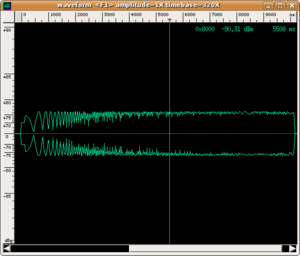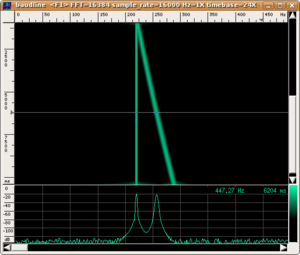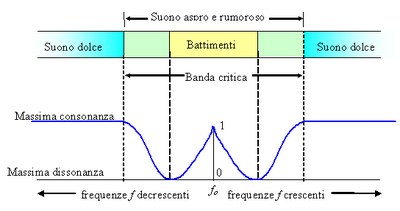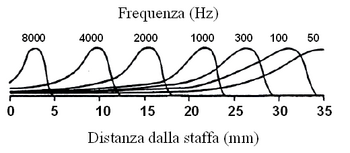Bande critiche en
Da "Fisica, onde Musica": un sito web su fisica delle onde e del suono, acustica degli strumenti musicali, scale musicali, armonia e musica.
Jump to navigation Jump to searchA direct experience
Listen to this sound of the superposition of a pure note (i.e. composed of a single harmonic fundamental) at a constant frequency of Hz with a variable frequency harmonic with continuity between 220 Hz and 290 Hz.
| Wave shape | Spectrogram | Audio | |
|---|---|---|---|

|

|
|
- At first, the two frequencies are equal and only the initial note is perceived;
- As soon as the variable frequency begins to detach from the value of , we perceive in the following order:
- a sound with a slowly oscillating intensity (this is the beat phenomenon);
- a sound in which the oscillations of intensity increase in frequency until they become a harsh sound that is extremely dissonant and irritating to the ear;
- a sound that becomes pleasant again but in which we clearly perceive the two notes that compose it as separate entities (this is what musicians call a bichord).
We can illustrate the results of this experience in a diagram such as the one below:
The moment in which the notes begin to be perceived as distinct is indicated by the horizontal line in the sonogram. Surprisingly, at that moment, the highest tone has a frequency of about 250 Hz. At that same moment, the two notes are at an interval of about a third; i.e. at a much greater distance than the frequency resolution for non-simultaneous sounds.
To verify this, listen to the following sample in which two sounds that are only 5 Hz apart are perceived as distinct by the average listener.
|
Puro_240_245_Hz.mp3 consecutive pure sounds: at 240 Hz and 245 Hz |
Its interpretation
Obviously, the interpretation of the listening in the previous paragraph is perceptive in nature. As shown in the sonogram, at every moment, there are only two distinct frequencies and there are no special properties of the sounds for which their perception should be variable. The interpretation is found in the physiology of the auditory system.
The first ever explanation, which was given by Hermann von Helmholtz,[1] was based on the positional theory, which was developed by Helmholtz himself. Basically, according to this theory:
- sounds that are very close in frequency stimulate very close positions of the basilar membrane compromising the ability of the nerve endings - activated by the oscillations of the membrane - to perceive the two sounds as distinct entities. If the difference in the frequency of the sounds is small, this simultaneous activation of the nervous fibres is well tolerated by the ear; however, when the difference in frequency increases (around 30-40 Hz according to Helmholtz) the sound assumes that harsh character that we experienced.
- Two sounds are perceived as distinct only if they involve sufficiently distant nerve endings; i.e. if they make different regions of the basilar membrane oscillate, which also means if they fall into in two distinct critical bands.
- Therefore, a critical band is an interval of frequencies within which two simultaneous pure tones cannot be perceived as distinct. Each critical band corresponds to a region of the basilar membrane with a length of about 1.3 mm.
The observations of Georg von Békésy[2] (Nobel prize winner in 1961 for his studies on the physiology of the inner ear) on the actual motion of the basilar membrane allowed for the "mapping" of the regions corresponding to various frequencies and showed that the area dedicated to each octave (i.e. for every doubling of frequency) is constant.
This implies that, with increasing frequency, the ratio between the amplitude of the region in question and the interval of frequencies that it is possible to perceive in that area is drastically reduced. Therefore, we have a natural explanation for why the critical band is wider at higher frequencies. It has been found that apart from the interval of frequencies below about 200 Hz, in which it remains constant, that width increases with frequency by the following approximate exponential law
This fact has notable consequences:
- it is difficult for our ear to discriminate two simultaneous high frequency sounds;
- it was used by Helmholtz to develop a theory of consonance and dissonance that attributes the higher or lower degree of consonance of musical intervals to the fact that the frequencies that compose them lie within or without of a single critical band.
In-depth study and links
- As we have repeatedly suggested in the text, we advise you to read the pages on Perception and Physiology of the auditory system.
- If you are interested in learning more about the musical aspects, visit the pages on Consonance and dissonance.
- If you are interested in executing experiments on the superposition of two sounds, you must visit our Virtual laboratory. In particular, on this page you will find instructions for executing an experiment on beats.
- ↑ Hermann L. F. von Helmholtz, Die Lehre von den Tonempfindungen, als Physiologische Grundlage für die Theorie der Musik (On the Sensations of Tone as a Physiological Basis for the Theory of Music), Vieweg, Braunschweig, 1863. You can read an online copy of the third edition in German (1870) or an English translation of the splendid introduction
- ↑ Georg von Békésy, Experiments in Hearing, McGraw-Hill, New York, 1960







